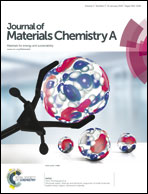Novel cathode-supported hollow fibers for light weight micro-tubular solid oxide fuel cells with an active cathode functional layer†
Abstract
Micro-tubular SOFCs have the potential to become light-weight portable auxiliary power units for aircraft or spacecraft. In this work, a novel dual-layer ceramic hollow fiber for a cathode-supported micro-tubular solid oxide fuel cell (MT-SOFC) has been successfully developed via a co-spinning-sintering technique. The green cathode hollow fibers, in dual layer configuration, consisting of a La0.8Sr0.2MnO3−δ (LSM) main layer and a LSM–Y2O3 stabilized ZrO2 (YSZ) functional layer with increased three phase boundary length, are first prepared by co-spinning, which are then sintered at around 1350 °C to allow the creation of sufficient mechanical strength. Other cell components like the electrolyte (YSZ) and anode (NiO + YSZ) are then coated separately. The coated electrolyte film with a thickness of around 27 μm is obtained by co-sintering of YSZ/LSM–YSZ/LSM in a sandwich structure. The porous LSM substrate functions as an oxygen-supplying and current collecting layer. The prepared MT-SOFC, tested with hydrogen as the fuel and air as the oxidant, delivers a maximum power density of up to 475 mW cm−2 at 850 °C, which is much higher than that of a similar cell without a cathode functional layer.


 Please wait while we load your content...
Please wait while we load your content...